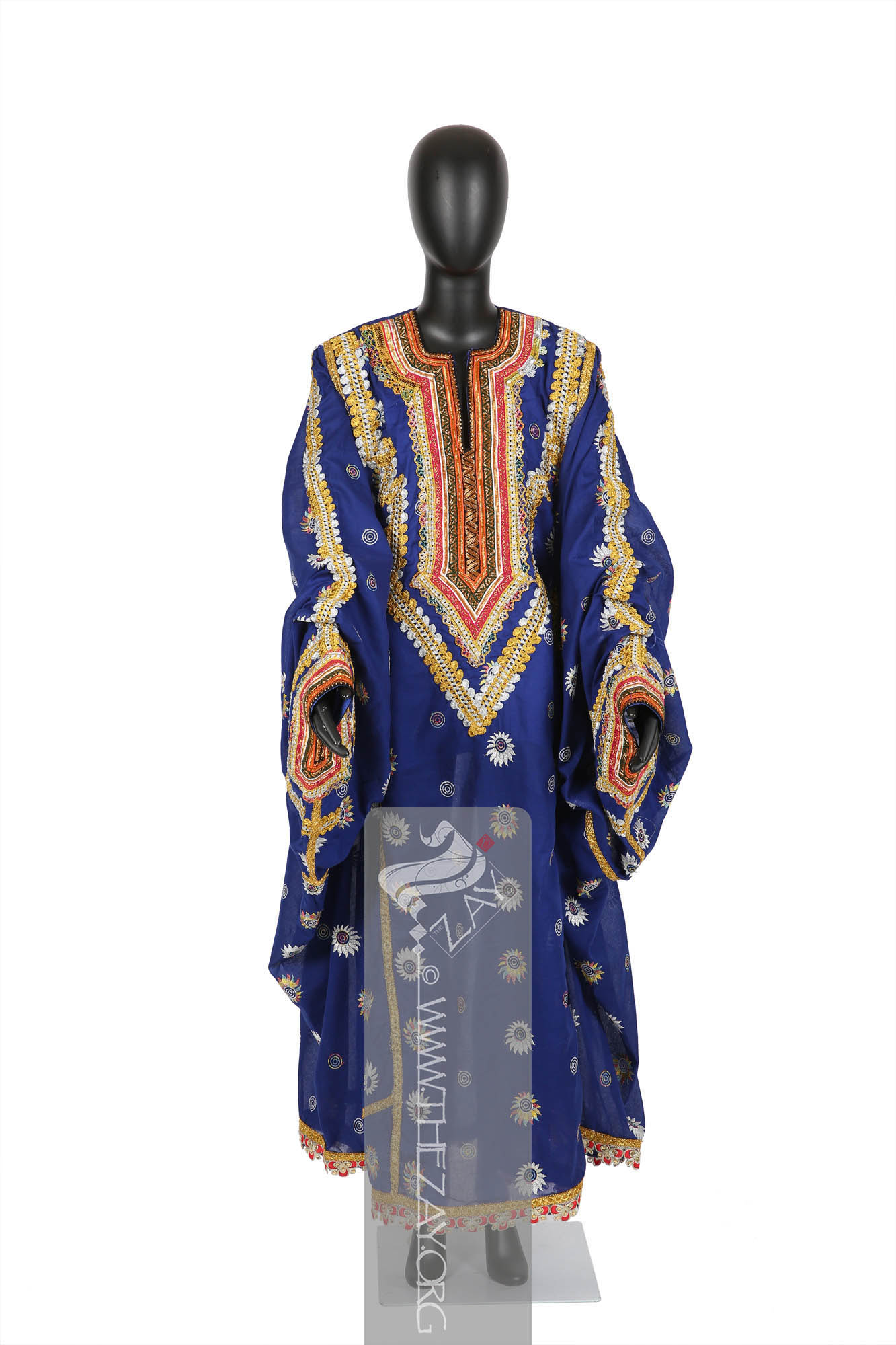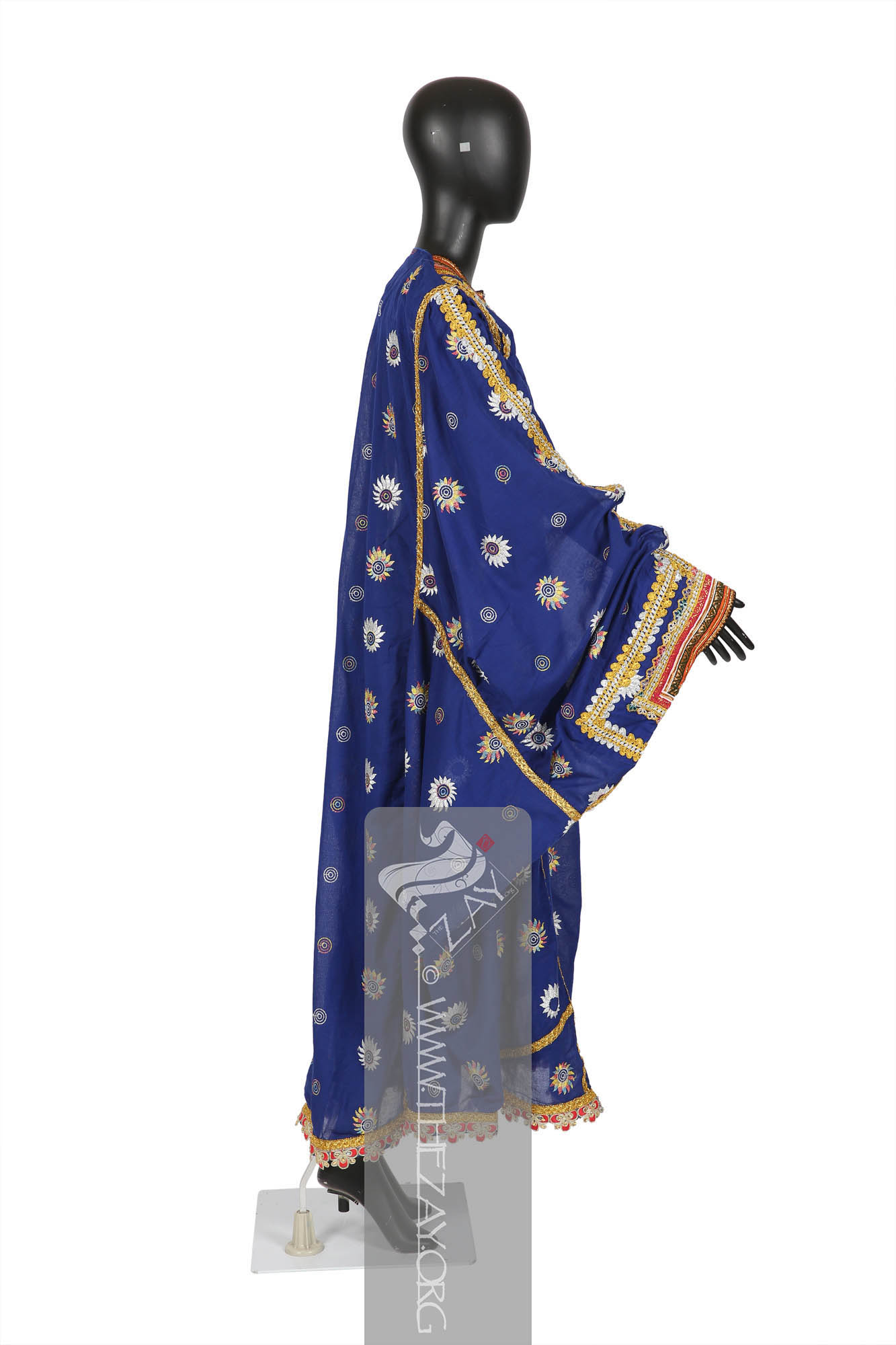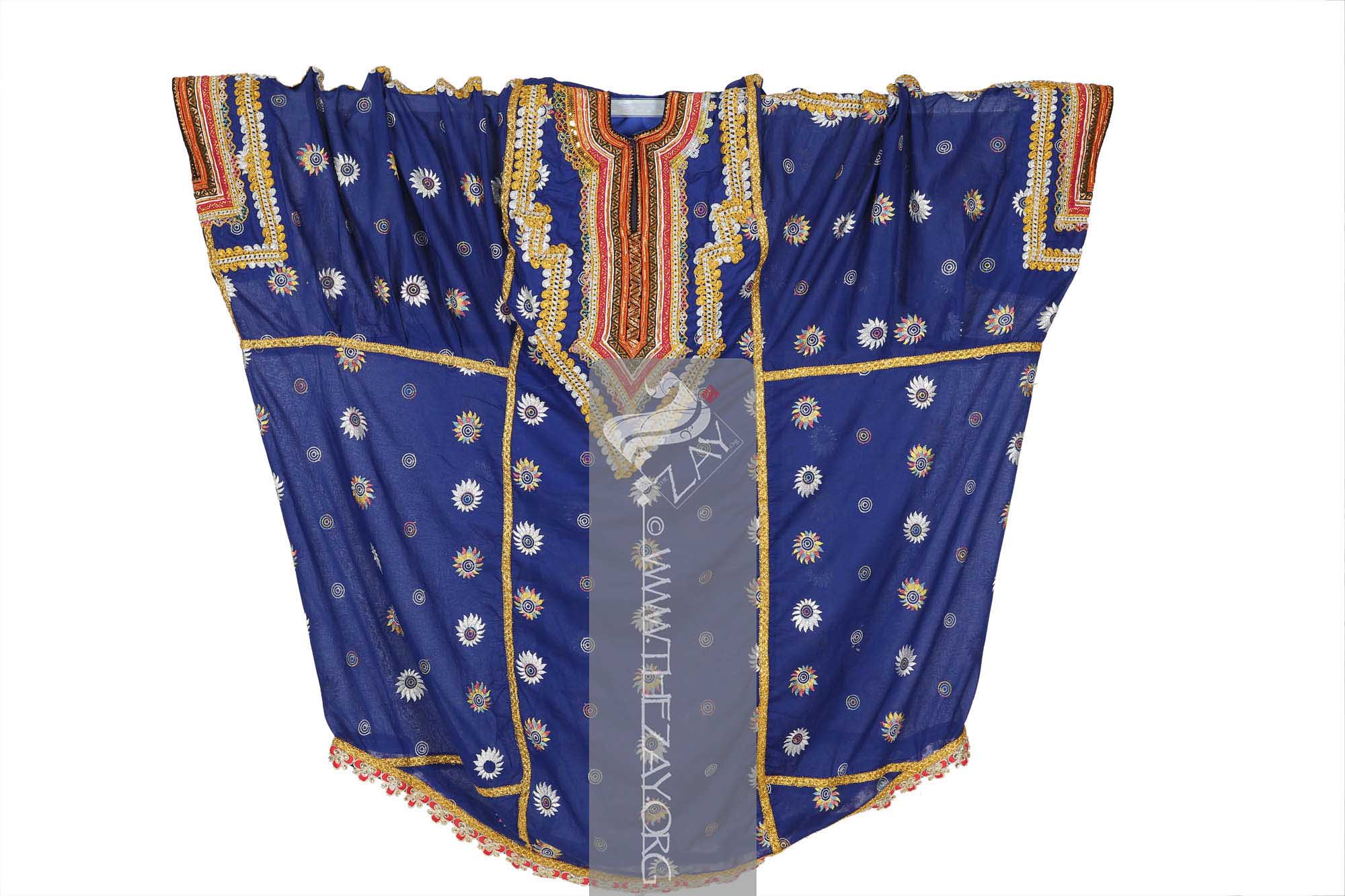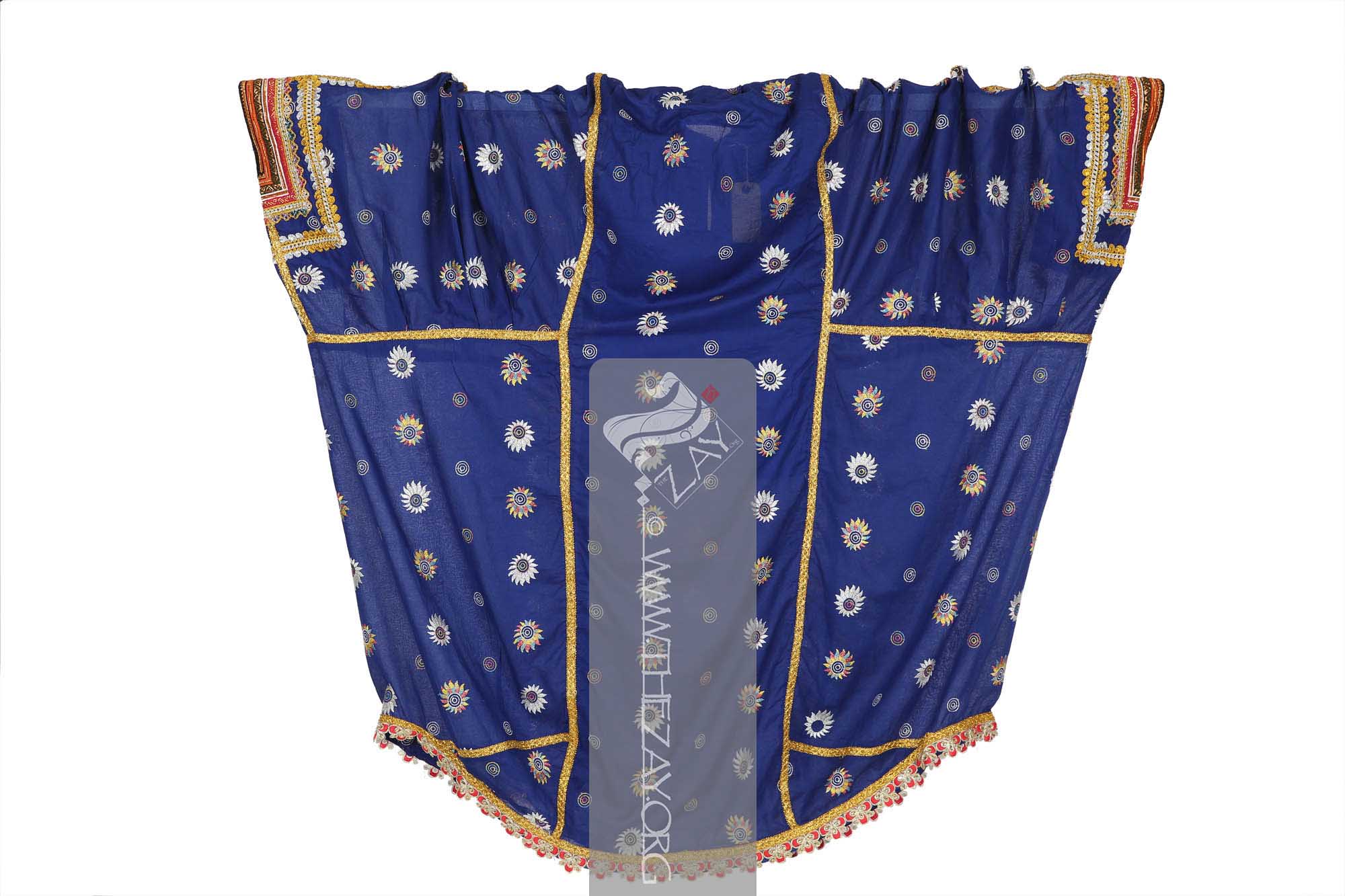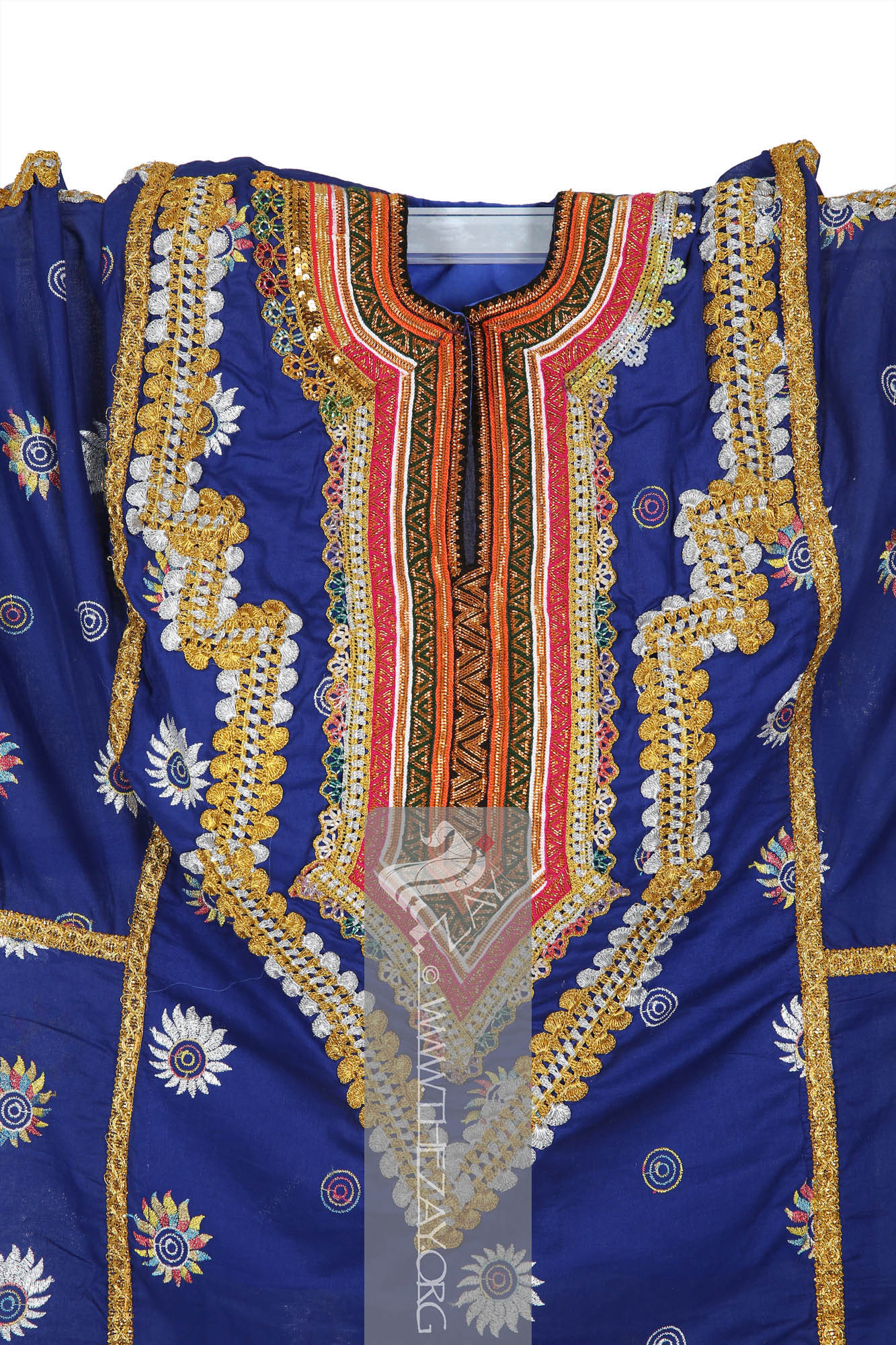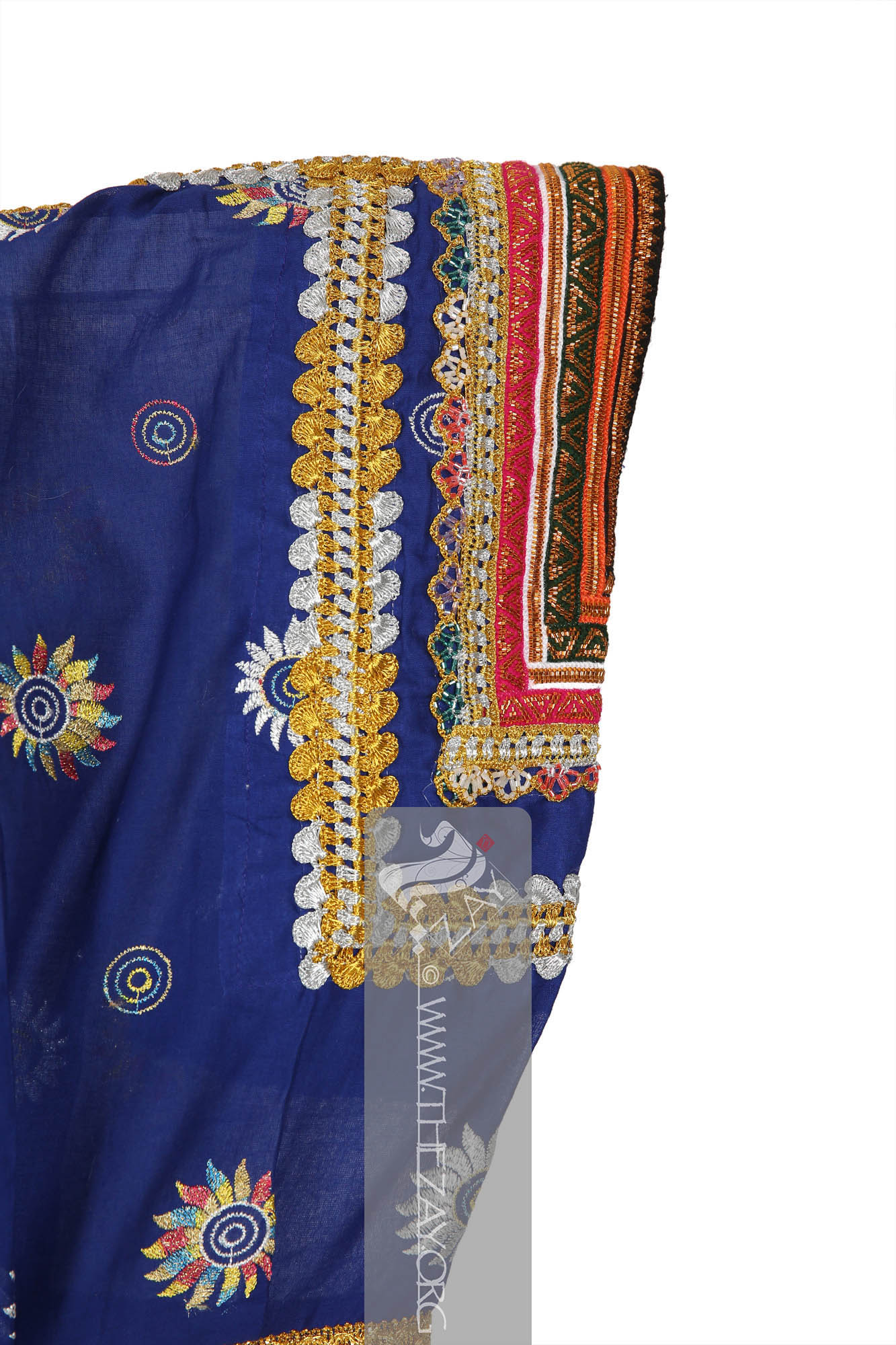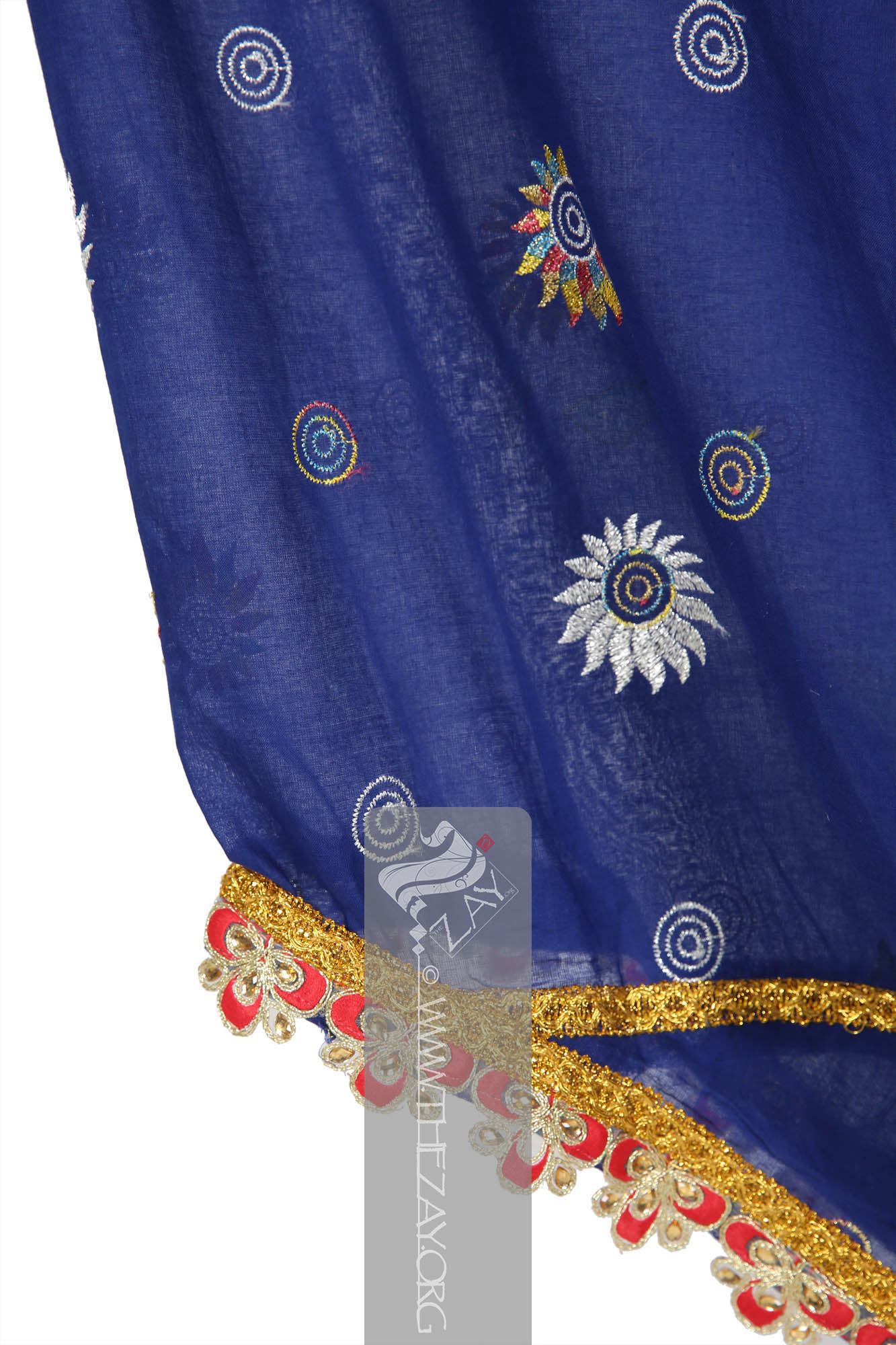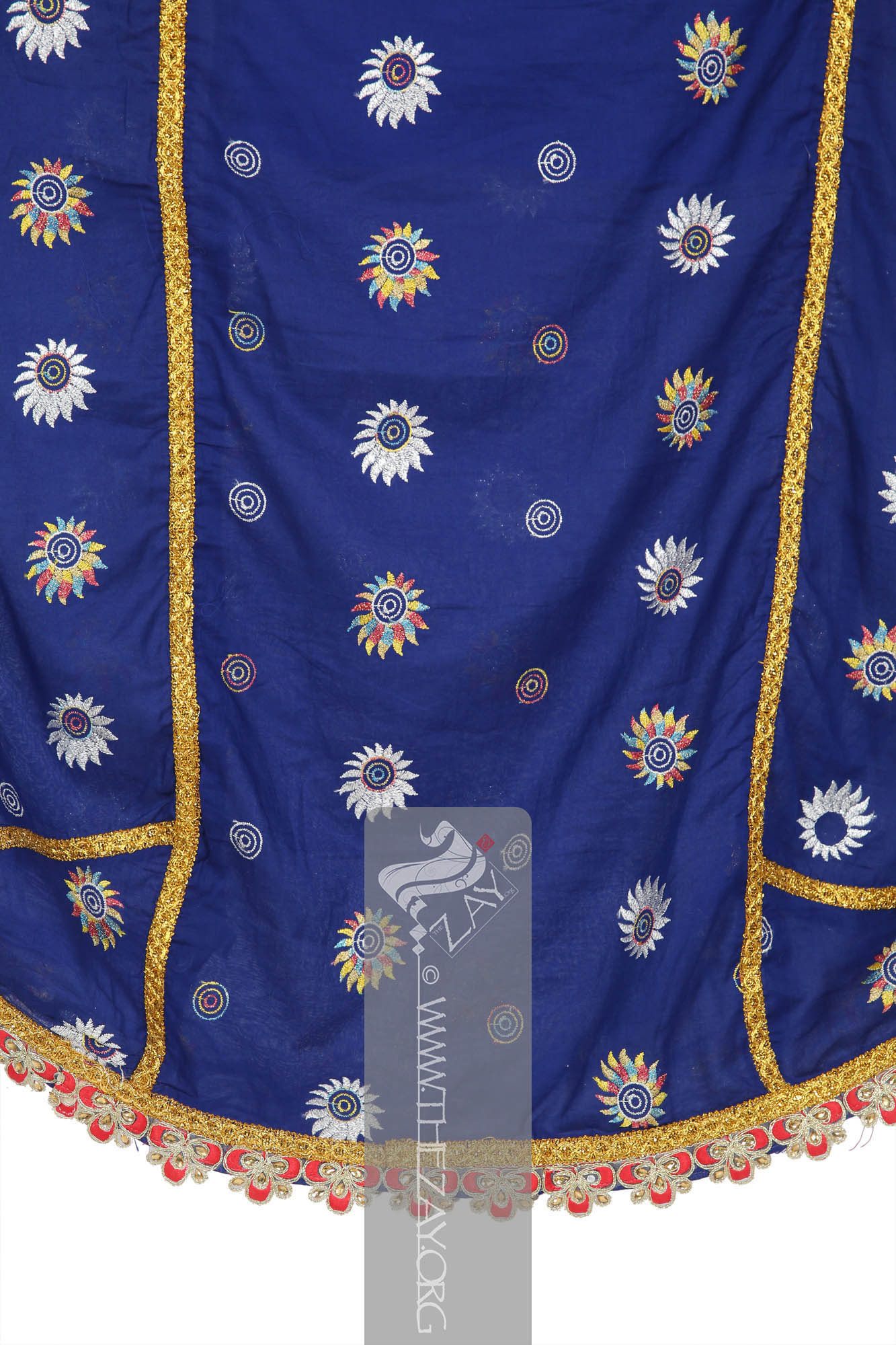Object NotePart of an ensemble containing two more items also in the collection (
ZI2018.500127a ASIA,
ZI2018.500127b ASIA).
Object HistoryThis ensemble was purchased by
Dr. Reem Tariq
Ṭariq: (Arabic; Synonym: tulle_bi_talli
Tūlle_bi_tallī: (French: Tulle – a city in France where fine material for veil was first made; Turkish: tel – wire; Synonym: tariq; talli; badla; khus_dozi ), series of small metal knots made on a woven net ground as embellishment. The term is commonly used in the North African Arab region specifically in Egypt.
; talli; badla; khus_dozi ), series of small metal knots made on a woven net ground as embellishment. The term is commonly used in the Levant Arab region specifically in Lebanon.
El Mutwalli
Dr. Reem Tariq
Ṭariq: (Arabic; Synonym: tulle_bi_talli
Tūlle_bi_tallī: (French: Tulle – a city in France where fine material for veil was first made; Turkish: tel – wire; Synonym: tariq; talli; badla; khus_dozi ), series of small metal knots made on a woven net ground as embellishment. The term is commonly used in the North African Arab region specifically in Egypt.
; talli; badla; khus_dozi ), series of small metal knots made on a woven net ground as embellishment. The term is commonly used in the Levant Arab region specifically in Lebanon.
el Mutwallī: Founder (CEO) of the Zay
Zay: (Arabic: costume, Pl. azyaā’), a set of clothes in a style typical of a particular country or historical period. Initiative, a public figure, speaker and author. An expert curator and consultant in Islamic art and architecture, interior design, historic costume, and UAE heritage. from an independent dealer from Bandar Abbas area in the south of Iran in 2018.
Object Features This is a blue women’s shift tunic dress common to the Bandar Abbas and Hormozgan areas in the south of Iran. Constructed of fine cotton this piece is possibly called a (
jama
Jāma: (Persian, Synonym: Juma
Jūma: (Persian, Synonym: Jama), a mantle to cover the torso. Amongst the women in south of Iran specially from Hormozgan it is a loose shift tunic dress, however the connotation changes and is used to refer to a shirt dress by the women further north.), a mantle to cover the torso. Amongst the women in south of Iran specially from Hormozgan it is a loose shift tunic dress, however the connotation changes and is used to refer to a shirt dress by the women further north./
juma
Jūma: (Persian, Synonym: Jama), a mantle to cover the torso. Amongst the women in south of Iran specially from Hormozgan it is a loose shift tunic dress, however the connotation changes and is used to refer to a shirt dress by the women further north.) with collar (
gariban
Garībān: (Proto Indo-Iranian: griHwaH, Sanskrit: grīvā́ – neck, throat), collar, placket, or neckline. Usually means a collar by the people of south of Iran in the Hormozgan area. ), this kind of loose shift tunic is often worn by older women of the region over a pair of trousers (
shalvar
shalvār: in Farsi, in the Emirati colloquial: ṣarwāl. In the Levantine colloquial: Shirwāl. Plural: sarāwīl, ṣarāwīl, sharāwīl, ṣarwīlāt). It is loose pants at the waist with folds, and narrow at the ankles. It is tied with a rope at the waist.) with tapering ankles.
The tunic is heavily embellished with metallic corded threads and trimmings, lace, rhinestones, silk
floss
Floss: (Old French: flosche – nap of velvet), is a type of silk fibre obtained from the cocoons of wild silkworms. It is characterized by its long, fluffy fibers that are not tightly woven, making it ideal for use in various textile applications such as embroidery, lace-making, and sewing. threads and coloured cylindrical sequins possibly made of glass or plastic. It is completely hand-stitched and hand-embroidered.
The front of the
yoke
Yoke: (Synonym: Bodice_Yoke), a structured pattern fitted at the shoulders defining the structure of women’s garments. Introduced in c. 1880s it defines the transition between the upper and lower parts of the garments and can now be found stitched-in where the blouse is separated from the skirt by a horizontal seam. is heavily embellished with silver and golden corded threads (
zari
Zarī: (Persian two-syllables: zar: gold & dozi: embellishment), complex embroidery technique that uses metal alloy on silk, satin, or velvet, and may include pearls, beads, and precious stones. Colloquially in the Arab gulf region, the term (zarī) is loosely applied to any gilded thread, embellishment or gilded brocade fabric. Originated in ancient Persia it has been used extensively in Indian and Middle Eastern textiles for centuries. ) (crocheted) into a lace-like pattern and a scalloped edging which is (
appliqued
Appliqued: (French: appliquer – Apply), ornamental needlework where small pieces of decorative fabric are sewn on to a larger piece to form a pattern.) on the
yoke
Yoke: (Synonym: Bodice_Yoke), a structured pattern fitted at the shoulders defining the structure of women’s garments. Introduced in c. 1880s it defines the transition between the upper and lower parts of the garments and can now be found stitched-in where the blouse is separated from the skirt by a horizontal seam. following which a variety of coloured cylindrical beads – lavender, green, white and
coral
Coral: (Greek: korallion, probably from Hebrew: goral – small pebbles), is a pale to medium shade of pink with orange or peach undertones, resembling the colour of certain species of coral. – are arranged in another series of scallops.
This is followed by a thin trimming of
zari
Zarī: (Persian two-syllables: zar: gold & dozi: embellishment), complex embroidery technique that uses metal alloy on silk, satin, or velvet, and may include pearls, beads, and precious stones. Colloquially in the Arab gulf region, the term (zarī) is loosely applied to any gilded thread, embellishment or gilded brocade fabric. Originated in ancient Persia it has been used extensively in Indian and Middle Eastern textiles for centuries. lace, which is finally topped with five tiers of metal foil embellished (
badlah
Bādlah: (Hindustani: badal – cloud from Sanskirt: vārdala – water; Synonym: tariq; talli
Tallī: (Turkish: tel – wire, string), Gulf Arab – a woven braided trimming made with metal wire, threads and ribbons often sewn on detachable panels used as embellishments. Other – (Synonym: tulle_bi_talli
Tūlle_bi_tallī: (French: Tulle – a city in France where fine material for veil was first made; Turkish: tel – wire; Synonym: tariq; talli; badla; khus_dozi ), series of small metal knots made on a woven net ground as embellishment. The term is commonly used in the North African Arab region specifically in Egypt.
; tariq; badla; khus_dozi), series of small metal knots made on a woven net ground as embellishment.
; tulle_bi_talli
Tūlle_bi_tallī: (French: Tulle – a city in France where fine material for veil was first made; Turkish: tel – wire; Synonym: tariq; talli; badla; khus_dozi ), series of small metal knots made on a woven net ground as embellishment. The term is commonly used in the North African Arab region specifically in Egypt.
; khus_dozi
Khus_dozi: (Persian: Khvosh – an Iranian province; dozi – needlework; Synonym: tariq; talli
Tallī: (Turkish: tel – wire, string), Gulf Arab – a woven braided trimming made with metal wire, threads and ribbons often sewn on detachable panels used as embellishments. Other – (Synonym: tulle_bi_talli
Tūlle_bi_tallī: (French: Tulle – a city in France where fine material for veil was first made; Turkish: tel – wire; Synonym: tariq; talli; badla; khus_dozi ), series of small metal knots made on a woven net ground as embellishment. The term is commonly used in the North African Arab region specifically in Egypt.
; tariq; badla; khus_dozi), series of small metal knots made on a woven net ground as embellishment.
; tulle_bi_talli
Tūlle_bi_tallī: (French: Tulle – a city in France where fine material for veil was first made; Turkish: tel – wire; Synonym: tariq; talli; badla; khus_dozi ), series of small metal knots made on a woven net ground as embellishment. The term is commonly used in the North African Arab region specifically in Egypt.
; badla), series of small metal knots made on a woven net ground as embellishment. The term is commonly used in Iran and parts of the Arabian Peninsula possibly because Khvosh was one of the centres for the craft.
), series of small metal knots made on a woven net ground as embellishment. The term is commonly used in India and parts of the subcontinent.
) strips on five different colours –
coral
Coral: (Greek: korallion, probably from Hebrew: goral – small pebbles), is a pale to medium shade of pink with orange or peach undertones, resembling the colour of certain species of coral., white, green, red and black – featuring different zigzag and other geometric patterns in different scales. These colourful bases are woven with wool.
A similar design with the same materials is reflected around the cuffs of the
jama
Jāma: (Persian, Synonym: Juma
Jūma: (Persian, Synonym: Jama), a mantle to cover the torso. Amongst the women in south of Iran specially from Hormozgan it is a loose shift tunic dress, however the connotation changes and is used to refer to a shirt dress by the women further north.), a mantle to cover the torso. Amongst the women in south of Iran specially from Hormozgan it is a loose shift tunic dress, however the connotation changes and is used to refer to a shirt dress by the women further north.. The entire field of the
jama
Jāma: (Persian, Synonym: Juma
Jūma: (Persian, Synonym: Jama), a mantle to cover the torso. Amongst the women in south of Iran specially from Hormozgan it is a loose shift tunic dress, however the connotation changes and is used to refer to a shirt dress by the women further north.), a mantle to cover the torso. Amongst the women in south of Iran specially from Hormozgan it is a loose shift tunic dress, however the connotation changes and is used to refer to a shirt dress by the women further north. has repeats of a spiral and a floral motif embellished using (
blanket_stitch
Blanket_stitch: A basic sewing stitch used to secure the edges of fabric or create decorative borders by looping the thread over the edges of blankets, quilts, and other fabrics and pulling it through, forming a series of evenly spaced stitches that resemble a chain. ) style embroidery alternately in ivory and multicoloured – yellow, pink and light blue – silk
floss
Floss: (Old French: flosche – nap of velvet), is a type of silk fibre obtained from the cocoons of wild silkworms. It is characterized by its long, fluffy fibers that are not tightly woven, making it ideal for use in various textile applications such as embroidery, lace-making, and sewing. threads. With silver tinsel highlights.
The use of the tinsel suggests that the dress was perhaps made sometime in circa mid-20th century. A metallic golden
zari
Zarī: (Persian two-syllables: zar: gold & dozi: embellishment), complex embroidery technique that uses metal alloy on silk, satin, or velvet, and may include pearls, beads, and precious stones. Colloquially in the Arab gulf region, the term (zarī) is loosely applied to any gilded thread, embellishment or gilded brocade fabric. Originated in ancient Persia it has been used extensively in Indian and Middle Eastern textiles for centuries. crocheted lace ribbon runs along the seams and the hem of the
jama
Jāma: (Persian, Synonym: Juma
Jūma: (Persian, Synonym: Jama), a mantle to cover the torso. Amongst the women in south of Iran specially from Hormozgan it is a loose shift tunic dress, however the connotation changes and is used to refer to a shirt dress by the women further north.), a mantle to cover the torso. Amongst the women in south of Iran specially from Hormozgan it is a loose shift tunic dress, however the connotation changes and is used to refer to a shirt dress by the women further north.. The hem is further embellished with
cutwork
Cutwork: It is a surface embroidery technique using two main stitches – the running stitch and the buttonhole stitch and is usually made on fine linen or cotton with threads that match the fabric colour. It creates a lace like pattern while the stitches prevent the fabric from fraying. floral edging ribbon made of golden
zari
Zarī: (Persian two-syllables: zar: gold & dozi: embellishment), complex embroidery technique that uses metal alloy on silk, satin, or velvet, and may include pearls, beads, and precious stones. Colloquially in the Arab gulf region, the term (zarī) is loosely applied to any gilded thread, embellishment or gilded brocade fabric. Originated in ancient Persia it has been used extensively in Indian and Middle Eastern textiles for centuries. ,
coral
Coral: (Greek: korallion, probably from Hebrew: goral – small pebbles), is a pale to medium shade of pink with orange or peach undertones, resembling the colour of certain species of coral. silk
floss
Floss: (Old French: flosche – nap of velvet), is a type of silk fibre obtained from the cocoons of wild silkworms. It is characterized by its long, fluffy fibers that are not tightly woven, making it ideal for use in various textile applications such as embroidery, lace-making, and sewing. threads and golden-coloured rhinestones.
The back of the dress reflects the same design as the front field with repeats of spiral and floral motifs.
Although the overall shape of the
jama
Jāma: (Persian, Synonym: Juma
Jūma: (Persian, Synonym: Jama), a mantle to cover the torso. Amongst the women in south of Iran specially from Hormozgan it is a loose shift tunic dress, however the connotation changes and is used to refer to a shirt dress by the women further north.), a mantle to cover the torso. Amongst the women in south of Iran specially from Hormozgan it is a loose shift tunic dress, however the connotation changes and is used to refer to a shirt dress by the women further north. resembles in style the overgarment from the Arabian Peninsula (
thawb
Thawb: (Arabic: thawb, Pl. Athwāb/thībān), can be pronounced thobe
Thobe: (Arabic: thawb, Pl. Athwāb/thībān), can be pronounced thawb or tobe
Tobe: (Arabic: thawb, Pl. Athwāb/thībān), can be pronounced thawb or thobe based on locale. The standard Arabic word for ‘fabric’ or ‘garment’. It can refer to a qamīs-like tunic worn by men and women in the Arabian Peninsula, Iraq, the southern and south-western ports and islands of Iran, and some countries in East and West Africa. More specifically, it can refer to the square-shaped Bedouin overgarment worn by women. based on locale. The standard Arabic word for ‘fabric’ or ‘garment’. It can also refer to a qamīs-like tunic worn by men and women in the Arabian Peninsula, Iraq, the southern and south-western ports and islands of Iran, and some countries in East and West Africa. More specifically, it can refer to the square-shaped Bedouin overgarment worn by women. or tobe
Tobe: (Arabic: thawb, Pl. Athwāb/thībān), can be pronounced thawb or thobe based on locale. The standard Arabic word for ‘fabric’ or ‘garment’. It can refer to a qamīs-like tunic worn by men and women in the Arabian Peninsula, Iraq, the southern and south-western ports and islands of Iran, and some countries in East and West Africa. More specifically, it can refer to the square-shaped Bedouin overgarment worn by women. based on locale. The standard Arabic word for ‘fabric’ or ‘garment’. It can also refer to a qamīs-like tunic worn by men and women in the Arabian Peninsula, Iraq, the southern and south-western ports and islands of Iran, and some countries in East and West Africa. More specifically, it can refer to the square-shaped Bedouin overgarment worn by women in the Arabian Gulf region. ) however, the neckline and the sleeves are vastly different. While the sleeves of the
jama
Jāma: (Persian, Synonym: Juma
Jūma: (Persian, Synonym: Jama), a mantle to cover the torso. Amongst the women in south of Iran specially from Hormozgan it is a loose shift tunic dress, however the connotation changes and is used to refer to a shirt dress by the women further north.), a mantle to cover the torso. Amongst the women in south of Iran specially from Hormozgan it is a loose shift tunic dress, however the connotation changes and is used to refer to a shirt dress by the women further north. have a small opening with small and embellished cuffs the sleeves of the Gulf
thawb
Thawb: (Arabic: thawb, Pl. Athwāb/thībān), can be pronounced thobe
Thobe: (Arabic: thawb, Pl. Athwāb/thībān), can be pronounced thawb or tobe
Tobe: (Arabic: thawb, Pl. Athwāb/thībān), can be pronounced thawb or thobe based on locale. The standard Arabic word for ‘fabric’ or ‘garment’. It can refer to a qamīs-like tunic worn by men and women in the Arabian Peninsula, Iraq, the southern and south-western ports and islands of Iran, and some countries in East and West Africa. More specifically, it can refer to the square-shaped Bedouin overgarment worn by women. based on locale. The standard Arabic word for ‘fabric’ or ‘garment’. It can also refer to a qamīs-like tunic worn by men and women in the Arabian Peninsula, Iraq, the southern and south-western ports and islands of Iran, and some countries in East and West Africa. More specifically, it can refer to the square-shaped Bedouin overgarment worn by women. or tobe
Tobe: (Arabic: thawb, Pl. Athwāb/thībān), can be pronounced thawb or thobe based on locale. The standard Arabic word for ‘fabric’ or ‘garment’. It can refer to a qamīs-like tunic worn by men and women in the Arabian Peninsula, Iraq, the southern and south-western ports and islands of Iran, and some countries in East and West Africa. More specifically, it can refer to the square-shaped Bedouin overgarment worn by women. based on locale. The standard Arabic word for ‘fabric’ or ‘garment’. It can also refer to a qamīs-like tunic worn by men and women in the Arabian Peninsula, Iraq, the southern and south-western ports and islands of Iran, and some countries in East and West Africa. More specifically, it can refer to the square-shaped Bedouin overgarment worn by women in the Arabian Gulf region. are completely open.
With cross-cultural lineages running deep between the communities living on either side of the Gulf, it is thus no wonder, that material culture such as this has found firm grounds on both sides.
Links 



